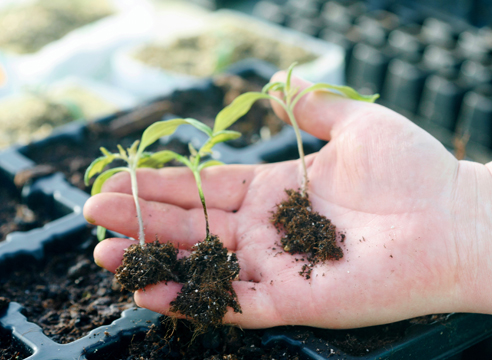 The black leg is a bacterial fungal disease, which is manifested by rotting of the root neck of seedlings. Visually, one can observe the manifestation of blackness on the legs of growing seedlings and their rapid destruction, due to which the sprout can no longer grow and die.
The black leg is a bacterial fungal disease, which is manifested by rotting of the root neck of seedlings. Visually, one can observe the manifestation of blackness on the legs of growing seedlings and their rapid destruction, due to which the sprout can no longer grow and die.
Content
Description
When growing peppers, the disease of the black leg most often manifests itself at the stage between the appearance of the first sprouts and the formation of 2-3 full leaflets on the stems. Often, the disease can be suspected by the condition of the leaves, but the reason lies in the already destroyed root in the lower part of the stem.
Microspores of dangerous fungi usually remain in the soil. They are not afraid of severe frosts and after processing the dead remains of last year's crop, weakened living structures are used. A particular danger is precisely for the weakened emerging seedlings of peppers, which must be protected. At the same time, healthy stronger plants are not susceptible to damage to the black leg.
The process of lesion of the black leg occurs through the root system with the entry into the stem. At this stage, bacteria actively pull out all the nutrients and juices from the plant. If the air temperature is above 5 degrees Celsius, and the soil itself is quite moist, bacteria begin to rapidly develop and multiply, and in geometric progression. The optimum temperature is about 25 degrees Celsius and humidity above 60%. After harvesting, the bacteria themselves remain viable for 4 years.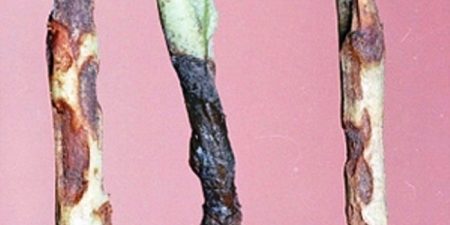
The causes of the appearance of the black leg
The death of pepper seedlings can result from non-compliance with the rules for its cultivation, as well as violation of the requirements for storage conditions. Among the main reasons for the active destruction of the sprouts of the black leg is to highlight:
- contamination of the used soil;
- too high density of sowing seeds;
- excessive soil moisture with stagnation of water;
- inadequate ventilation of the room and containers in which pepper itself is grown;
- excessively high room temperature;
- sudden changes in air temperature.
The process of destruction of sprouts after infection with a black leg lasts, as a rule, about a week.
What does the black leg look like?
Infectious fungi are present in almost any soil and begin to activate when suitable conditions occur. When the seedlings are infected, the acquisition of brown color by the subcotyledon knee is first observed. Then there is a thinning of the stems, the tissues of which rapidly soften and become watery. As a result of all this, after 5 to 7 days, the plants simply fall, as if mowed.
In order to prevent the spread of the disease in advance and save the seedlings, it is necessary to carefully examine the seedlings daily, especially the root part. After all, timely first aid will help stop the defeat of the remaining sprouts. The first thing to watch out for is the darkening of the root neck of the seedlings and their gradual withering in sunny warm weather.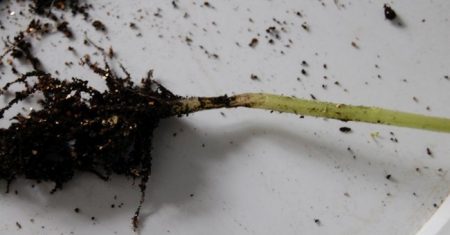
How to identify a black leg in seedlings
Since the source of danger in the form of a black leg lives in the ground, the first lesions of pepper seedlings can not always be immediately noticed. In addition, the disease itself is of a focal type and not all seedlings fall ill at the same time. With a thorough examination of the growing seedlings, it is important to pay attention to the color and condition of the lower part of the stem.The appearance of dark spots on the legs testifies to the disease itself, and also the stalk itself becomes soft and watery.
If such features are found, it is extremely important to examine those stems that grow near the damaged one. Proper and timely tillage will save seedlings and rely on its good productivity in the form of beautiful juicy peppers.
Hole protection against black legs
One of the effective ways to protect plants from being damaged by a black leg is gentle and at the same time simple hilling. The method is as follows:
- As soon as the first sprouts begin to appear on the surface of the soil, watering of the soil stops for at least 2 to 3 days.
- Sufficiently dried soil must be carefully loosened, and rows of seedlings spud.
- The next watering is carried out moderately and clearly in the formed grooves between the rows of seedlings. This will allow the stems to remain dry and thereby prevent the growth of existing bacteria in the soil.
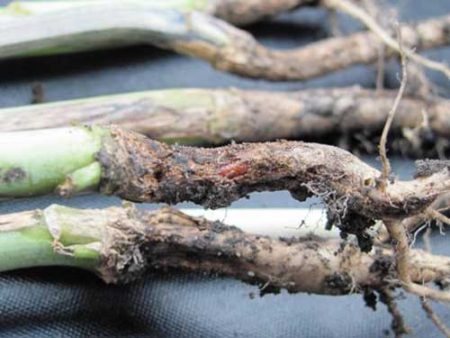
The procedure itself must be repeated after 4 to 5 days, until the sprouts are stronger.
How to deal with the disease
More effective than any treatment is only the prevention of the disease itself. That is why it is worth using quality seeds as well as healthy fertilized soil in your work. One of the important tips is to sow the seeds no earlier than indicated on the packaging. Such a mistake can lead to a decrease in their immunity, which means that the shoots will be more vulnerable to the disease of the black leg.
As a preventive measure, it is also recommended to use special peat tablets or to sow future seedlings in separate pots or any other containers. If the first lesions of the seedlings were observed with dark spots and with destroyed roots, the plants themselves must be completely removed from the tank. After a detailed examination of the remaining seedlings, a bright pink solution of potassium permanganate is used in a ratio of 3 g per 10 liters of water, which is used to treat the soil.
Alternatively, a solution of Fitosporin (100 ml per 10 liters of water) can be used. The soil itself is necessarily watered by it, and plants are also sprayed. A topical replacement for Fitosporin is 1% Bordeaux fluid. Additionally, you need to sprinkle the soil with a mixture of sifted wood ash and copper sulphate (1 cup per 1 teaspoon, respectively).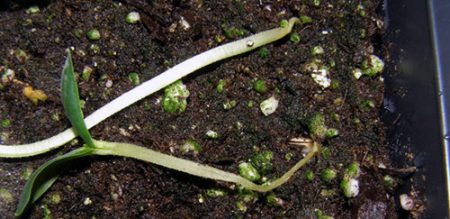
If infection is detected in most of the seedlings, it is extremely important to separate still healthy seedlings into separate disinfected containers. Affected seedlings must be destroyed along with the soil. Transplanted plants are placed in warm conditions with a temperature of at least 18 - 20 degrees Celsius and set in the shade of sunlight. The new soil should dry for several days, and then it is treated with a fungicide, for example, Bactofit. After 6-8 days, the sprouts should take root and only then the seedlings are transferred to a cooler place.
Proven effectiveness is also distinguished by a soda solution prepared in the ratio of 1 teaspoon per glass of water. They need to water the soil, but only after the diseased seedlings are completely eliminated.
Prevention
One of the important features of the disease of the black leg is the rapid reproduction with increased acidity of the soil itself.In such cases, it is recommended to pre-treat the soil using:
- dolomite flour;
- lime;
- chalk;
- furnace ash.
In addition, the soil on which peppers, eggplants or tomatoes grew last year is not suitable for growing seedlings. It is better to make a choice in favor of soils where garden greens, such as parsley, or celery previously grew. The soil on which beans or peas and leaf mustard were grown last year will be favorable for use.
Of the mandatory manipulations, the soil is irrigated with a boiling dark pink solution of potassium permanganate. For maximum steaming, the container is covered with a protective film. Sowing seeds in this case is carried out only after the soil has completely cooled down. Soil treatment with copper sulfate will not be superfluous.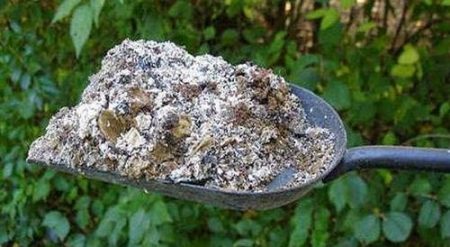
In addition to soil treatment and the use of high-quality seeds, special attention should be paid to the sterility of the seeds used and the careful picking of the seedlings themselves. If the drawers have already been used before, it is recommended to wash them thoroughly with a soap solution or any other disinfectant solution, as well as rinse well.
You should also abandon the use of unripened compost as soil fertilizer, since it provides the best conditions for enhancing the activity of fungal spores.
Creating a microclimate
Based on the features of the activation of fungal diseases in the soil, care should be taken in advance to create an appropriate microclimate for growing seedlings. First of all, this applies to the following rules:
- the product of the next watering of seedlings only after moderate drying of the soil after the previous one;
- during irrigation, water should be directed to the ground, without affecting the leaves and stems;
- the protective film is removed as soon as the first sprouts begin to appear, it is it that creates a dangerous condensate, increases humidity and prevents the saturation of seedlings with oxygen;
- growing seedlings must be carried out in a warm place with good lighting;
- not to allow too thick sowing of the soil, the optimal distance is at least 0.7 - 1 cm.
In addition, during irrigation it is not recommended to use nitrogen fertilizers. This leads to the fact that the stems are excessively stretched and become thinner, and therefore, more vulnerable. Sudden temperature changes are also unacceptable.
Reviews
Ekaterina Alexandrovna, 48 years old
For the prevention of black leg disease, it is recommended to use fungicides, for example, Fitolavin. With its solution it is possible to process not only the soil for seedlings, but also the bushes themselves. The tool is universal. The only caveat concerns the need to carry out work 2 to 3 weeks before transplanting bushes on a permanent ground. Of the tested folk remedies, it is worth paying attention to the infusion of onion peel and diluted alcohol in a ratio of 1 to 10. Spraying must be repeated again after 6 to 8 days.




 Calorie pepper stuffed with meat and rice - BZHU per 100 grams
Calorie pepper stuffed with meat and rice - BZHU per 100 grams Gorky pepper - the best varieties for open ground
Gorky pepper - the best varieties for open ground Hot pepper seeds - the best varieties for open ground and reviews
Hot pepper seeds - the best varieties for open ground and reviews Capsicum tincture for hair - how to use and reviews
Capsicum tincture for hair - how to use and reviews